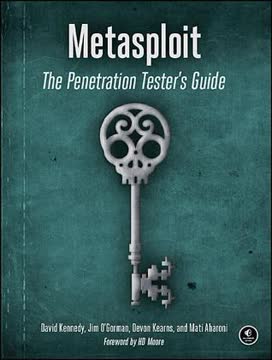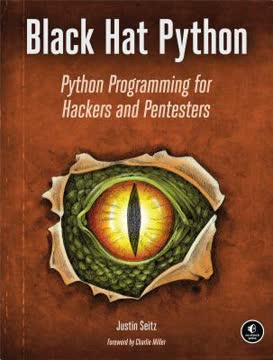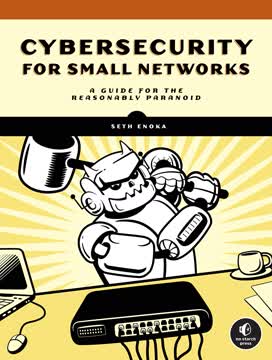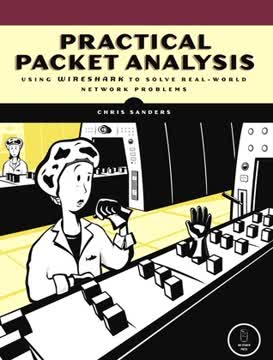Key Takeaways
1. Packet Analysis Unveils Network Truths
All network problems stem from the packet level, where even the prettiest looking applications can reveal their horrible implementations, and seemingly trustworthy protocols can prove malicious.
Beyond the Surface. Packet analysis, or "sniffing," is the art of capturing and interpreting live network data to understand what's really happening. It's like a network detective's toolkit, allowing you to bypass misleading interfaces and get to the raw truth of data flow. This technique is invaluable for understanding network characteristics, identifying bandwidth hogs, detecting malicious activity, and finding bloated applications.
Essential for Troubleshooting. Whether you're a network technician, administrator, or security analyst, packet analysis empowers you to solve problems by examining the fundamental units of network communication. It allows you to identify connectivity issues, DNS problems, slow speeds, and malware infections. By understanding the language of packets, you can diagnose and resolve issues that would otherwise remain hidden.
Choosing the Right Tool. Selecting a packet sniffer involves considering supported protocols, user-friendliness, cost, program support, and operating system compatibility. While commercial options offer fancy reporting, free tools like Wireshark provide robust analysis capabilities and are supported by active communities. The key is to choose a tool that fits your expertise and the specific needs of your network environment.
2. Strategic Sniffer Placement is Key
The challenge with sniffer placement is that a large variety of networking hardware is used to connect devices.
Tapping into the Wire. Effective packet analysis hinges on strategically positioning your packet sniffer to capture the relevant data. This process, known as "tapping the network," requires understanding how different networking devices—hubs, switches, and routers—handle traffic. Simply plugging into a random port won't cut it.
Navigating Switched Networks. In switched environments, where traffic is directed only to intended recipients, you need techniques like port mirroring (copying traffic from one port to another), hubbing out (segmenting the target device with a hub), using a network tap (a hardware device for intercepting traffic), or ARP cache poisoning (redirecting traffic by manipulating ARP tables). Each method has its pros and cons, depending on your access, the switch's capabilities, and the need for stealth.
Routed Environments. In routed environments, where data traverses multiple networks, sniffer placement becomes even more critical. You may need to analyze traffic on both sides of a router to get the full picture. Network maps are invaluable for visualizing the network and determining optimal sniffer placement.
3. Wireshark: Your Indispensable Analysis Tool
It’s the dedication of Gerald and the hundreds of other developers that makes Wireshark such a great analysis platform.
A Packet Analysis Powerhouse. Wireshark is a free, open-source packet analyzer that has become the industry standard. Its benefits include support for a vast range of protocols (over 850), a user-friendly GUI, and a vibrant community providing support and updates. Wireshark runs on all major operating systems, making it a versatile tool for any network professional.
Key Features. Wireshark's main window is divided into three panes: the Packet List (showing captured packets), the Packet Details (displaying hierarchical information about a selected packet), and the Packet Bytes (showing the raw, unprocessed data). Customization options, such as color coding and time display formats, enhance usability.
Getting Started. To capture packets, select Capture > Interfaces, choose the desired interface, and click Start. Wireshark will begin capturing data, which you can then analyze using its various features. Understanding the main window and customizing preferences are essential first steps in mastering Wireshark.
4. Filters: Precision Tools for Packet Selection
Simply stated, a filter is an expression that defines criteria for the inclusion or exclusion of packets.
Two Types of Filters. Filters are essential for focusing on specific traffic within a capture. Capture filters, applied during the capture process, use Berkeley Packet Filter (BPF) syntax to select only the packets you need, improving performance. Display filters, applied to existing captures, allow you to hide unwanted packets or show desired packets based on specified expressions.
BPF Syntax. Capture filters use BPF syntax, which involves combining qualifiers (type, direction, protocol) with identifiers (names or numbers) to create expressions. Logical operators (AND, OR, NOT) can combine primitives for more complex filtering. Examples include:
host 172.16.16.149(captures traffic associated with a specific host)port 8080(captures traffic on port 8080)icmp[0] == 3(captures ICMP destination unreachable messages)
Display Filter Syntax. Display filters use a different syntax, offering more flexibility for analyzing captured data. Comparison operators (==, !=, >, <, >=, <=) and logical operators (and, or, xor, not) can be combined to create powerful expressions. Examples include:
ip.addr==192.168.0.1(displays packets with a specific IP address)frame.len <= 128(displays packets less than 128 bytes)tcp.flags.syn==1(displays TCP packets with the SYN flag set)
5. Advanced Features for Deep Dive Analysis
This chapter introduces Wireshark.
Endpoints and Conversations. The Endpoints window (Statistics > Endpoints) displays statistics for each network endpoint, including addresses, packets, and bytes transmitted/received. The Conversations window (Statistics > Conversations) shows communication between endpoints, divided by protocol. These windows are crucial for identifying top talkers and troubleshooting network issues.
Protocol Hierarchy Statistics. The Protocol Hierarchy Statistics window (Statistics > Protocol Hierarchy) provides a breakdown of protocol distribution in a capture file, allowing you to benchmark network activity and identify anomalies. This is a great way to get a snapshot of the type of activity occurring on a network.
Name Resolution. Name resolution converts alphanumeric addresses into more recognizable names, making capture files more readable. Wireshark supports MAC, network, and transport name resolution. However, name resolution can fail, generate additional traffic, and require processing overhead.
6. Lower-Layer Protocols: The Foundation of Communication
In order to understand the functionality of IPv4, you need to know how traffic flows between networks.
ARP: Resolving Physical Addresses. The Address Resolution Protocol (ARP) translates IP addresses to MAC addresses, enabling communication on a local network segment. ARP requests are broadcast to find the MAC address associated with a specific IP, while ARP responses provide the mapping. Gratuitous ARP packets update ARP caches when IP addresses change.
IP: Routing Data Between Networks. The Internet Protocol (IP) is responsible for routing data between networks. IPv4 addresses are 32-bit addresses written in dotted-quad notation. IP packets include a Time to Live (TTL) field to prevent routing loops and a header checksum for error detection.
TCP: Reliable Data Delivery. The Transmission Control Protocol (TCP) provides reliable, connection-oriented data transport. TCP uses a three-way handshake (SYN, SYN/ACK, ACK) to establish connections and a four-way teardown (FIN/ACK, ACK, FIN/ACK, ACK) to gracefully end them. TCP also employs sequence numbers, acknowledgment numbers, and a sliding window mechanism for flow control and error recovery.
7. Upper-Layer Protocols: Application-Level Insights
The beauty of working with an open source application is that if you are confused as to why something is occurring, you can look at the source code and find out the exact reason.
DHCP: Automatic IP Configuration. The Dynamic Host Configuration Protocol (DHCP) automatically assigns IP addresses and other network parameters to clients. The DORA process (Discover, Offer, Request, Acknowledgment) is used to obtain an IP address. DHCP options provide additional configuration information, such as DNS server addresses and default gateway.
DNS: Translating Names to Addresses. The Domain Name System (DNS) translates domain names (e.g., www.google.com) to IP addresses. DNS queries are sent to DNS servers, which respond with the requested information. DNS recursion allows servers to query other servers on behalf of clients. Zone transfers replicate DNS data between servers.
HTTP: Delivering Web Content. The Hypertext Transfer Protocol (HTTP) is used to deliver web content. HTTP uses request methods (e.g., GET, POST) to interact with web servers. HTTP response codes indicate the status of requests. Following TCP streams in Wireshark allows you to view HTTP conversations in a readable format.
8. Basic Real-World Scenarios: Troubleshooting in Action
There is no better way to determine the placement of your packet sniffer than to be able to visualize a network.
Social Networking at the Packet Level. Analyzing traffic from Twitter and Facebook reveals different approaches to authentication and messaging. Twitter uses HTTPS for login but sends direct messages in plaintext. Facebook also uses HTTPS for login and AJAX for messaging.
Capturing ESPN.com Traffic. Analyzing traffic from ESPN.com demonstrates how a single web page can involve multiple connections and protocols. The Conversations and Protocol Hierarchy Statistics windows provide insights into the traffic distribution.
Real-World Problems. Common network problems include no Internet access due to configuration problems, unwanted redirection due to hosts file entries, and upstream problems with remote servers. Packet analysis can help pinpoint the source of these issues.
9. Combating Network Sluggishness: TCP's Role
TCP’s error-recovery features are our best tools for locating, diagnosing, and eventually repairing high latency on a network.
TCP Error Recovery. TCP's error-recovery features are essential for diagnosing network latency. TCP uses retransmissions to recover from packet loss, with the retransmission timer (RTO) determining when to resend packets. Duplicate ACKs signal out-of-order packets, triggering fast retransmissions.
TCP Flow Control. TCP implements a sliding-window mechanism to prevent packet loss. The receive window, advertised by the data recipient, controls the flow of data. Adjusting the window size and using zero window notifications help manage congestion.
Locating Latency Sources. High latency can stem from wire latency (network devices), client latency (client processing), or server latency (server processing). Analyzing the TCP handshake and initial data packets can help pinpoint the source.
10. Packet Analysis Fortifies Network Security
This book is dedicated to God, my parents, and everyone who has ever shown faith in me.
Reconnaissance. Attackers often begin by scanning for open ports and running services. TCP SYN scans are a common technique for identifying open ports. Operating system fingerprinting, both passive and active, helps attackers determine the target's operating system.
Exploitation. Exploitation involves leveraging vulnerabilities to gain access to a system. Operation Aurora exploited an Internet Explorer vulnerability to gain remote control of targeted machines. ARP cache poisoning can redirect traffic for man-in-the-middle attacks.
Remote Access Trojans. Remote Access Trojans (RATs) allow attackers to remotely administer compromised machines. Analyzing traffic from RATs can reveal command structures and data exfiltration techniques.
11. Wireless Networks: A Unique Analysis Landscape
This book was made possible through the direct and indirect contributions of a great number of people.
Physical Considerations. Wireless packet analysis differs from wired analysis due to the shared wireless spectrum. You can only sniff one channel at a time, and wireless signal interference can affect data integrity. Spectrum analyzers, like MetaGeek's Wi-Spy, can help detect interference.
Wireless Card Modes. Wireless NICs operate in different modes: managed, ad hoc, master, and monitor. Monitor mode is essential for capturing wireless packets. Tools like AirPcap overcome Windows limitations on wireless packet capture.
802.11 Packet Structure. Wireless packets include an 802.11 header with information about the packet and transmission medium. Wireless-specific filters, such as wlan.bssid and radiotap.channel.freq, help isolate traffic. Wireless security protocols, like WEP and WPA, encrypt data transmitted over the air.
Last updated:
FAQ
What’s Practical Packet Analysis: Using Wireshark to Solve Real-World Network Problems by Chris Sanders about?
- Comprehensive packet analysis guide: The book teaches readers how to use Wireshark to capture and analyze network packets for solving real-world network problems, from basic connectivity issues to advanced security threats.
- Focus on practical scenarios: It emphasizes hands-on learning with real capture files and scenarios, including troubleshooting slow networks, diagnosing connectivity issues, and analyzing security incidents.
- Covers protocols and security: The book explores both foundational network protocols and advanced topics like wireless analysis and security-focused packet analysis.
Why should I read Practical Packet Analysis by Chris Sanders?
- Practical, hands-on approach: The book stands out for its real-world examples and exercises, helping readers gain experience that closely mirrors actual troubleshooting situations.
- Accessible for all levels: Chris Sanders uses clear, jargon-minimized language, making complex networking concepts understandable for beginners and valuable for intermediate users.
- Covers troubleshooting and security: Readers learn not just how to capture packets, but also how to use analysis for troubleshooting, malware detection, and enhancing network security.
What are the key takeaways from Practical Packet Analysis by Chris Sanders?
- Master packet analysis fundamentals: Readers gain a solid understanding of how packet sniffers work, the OSI model, and the importance of analyzing network traffic at the packet level.
- Proficiency with Wireshark: The book provides step-by-step guidance on using Wireshark’s features, from basic capture to advanced analysis tools.
- Real-world troubleshooting skills: It equips readers to diagnose and resolve common network issues, analyze security threats, and understand protocol behaviors in depth.
What are the most notable quotes from Practical Packet Analysis by Chris Sanders and what do they mean?
- “Stop guessing and start troubleshooting the problems on your network.” This quote highlights the book’s emphasis on using data-driven analysis rather than guesswork.
- “All network problems stem from the packet level.” Sanders underscores the importance of understanding packets to effectively solve network issues.
- “If you have faith as small as a mustard seed, you can say to this mountain, ‘Move from here to there’ and it will move. Nothing will be impossible for you.” (Matthew 17:20) The author dedicates the book to perseverance and confidence in tackling complex challenges.
How does Practical Packet Analysis by Chris Sanders explain the OSI model and its relevance to packet analysis?
- Seven-layer breakdown: The book details each OSI layer’s function, from physical hardware to application interfaces, clarifying how protocols operate at each level.
- Layer interaction and encapsulation: It explains how data is encapsulated and decapsulated as it moves through the OSI layers during transmission and reception.
- Troubleshooting framework: Sanders uses the OSI model to help readers classify and diagnose network problems, such as identifying “layer 3” routing issues.
What foundational network protocols does Practical Packet Analysis by Chris Sanders cover, and why are they important?
- ARP, IP, TCP, UDP, ICMP: The book provides in-depth explanations of these lower-layer protocols, including their packet structures and typical behaviors.
- Protocol roles in communication: Readers learn how ARP resolves addresses, how IP handles addressing and fragmentation, and how TCP and UDP manage data delivery.
- ICMP for diagnostics: The book covers ICMP’s role in utilities like ping and traceroute, essential for network troubleshooting.
How does Practical Packet Analysis by Chris Sanders teach Wireshark usage for packet capture and analysis?
- Installation and setup: Step-by-step instructions guide readers through installing Wireshark, selecting interfaces, and starting/stopping captures.
- Working with capture files: The book explains how to save, merge, and export capture files for later analysis.
- Filters and display: Detailed guidance is provided on using capture and display filters, as well as color coding, to efficiently isolate relevant packets.
What advanced Wireshark features does Practical Packet Analysis by Chris Sanders cover?
- Endpoints and conversations: Readers learn to identify top talkers and communication pairs using Wireshark’s endpoints and conversations views.
- Protocol hierarchy and expert info: The book demonstrates how to use protocol distribution statistics and expert system alerts to spot anomalies.
- Graphing and stream following: Sanders covers IO graphs for traffic visualization, round-trip time graphs for latency analysis, and following TCP streams to reconstruct conversations.
How does Practical Packet Analysis by Chris Sanders address troubleshooting common network problems like no internet access?
- Step-by-step packet analysis: The book presents real-world scenarios where users face connectivity issues, guiding readers through capturing and analyzing relevant packets.
- Focus on ARP and DNS: It highlights the importance of ARP requests and DNS queries in diagnosing issues like misconfigured gateways or incorrect hosts file entries.
- Wireshark tools for diagnosis: Readers learn to use Wireshark’s Conversations and Protocol Hierarchy windows to identify traffic patterns and pinpoint problems.
What techniques does Practical Packet Analysis by Chris Sanders teach for identifying and resolving slow network performance?
- TCP error-recovery features: The book explains how to detect retransmissions, duplicate ACKs, and zero window notifications to identify packet loss and latency.
- Latency source identification: Sanders teaches how to analyze TCP handshakes and HTTP requests to distinguish between wire, client, and server latency.
- Network baselining: Readers learn to create baselines for sites, hosts, and applications using Wireshark’s statistics and graphing features.
How does Practical Packet Analysis by Chris Sanders approach packet analysis for security and wireless networks?
- Security-focused analysis: The book covers reconnaissance techniques, exploitation examples, and man-in-the-middle attacks like ARP cache poisoning.
- Wireless packet analysis: Sanders explains wireless spectrum challenges, NIC modes (including monitor mode), and security protocols like WEP and WPA.
- Wireless integration with Wireshark: The book shows how to configure AirPcap and add wireless-specific columns and filters for effective wireless packet capture.
What additional resources and tools does Practical Packet Analysis by Chris Sanders recommend for further learning and packet analysis?
- Packet analysis tools: The book lists tools such as tcpdump, Cain & Abel, Scapy, Netdude, Colasoft Packet Builder, CloudShark, and NetworkMiner for various analysis needs.
- Learning resources: Sanders recommends websites, blogs, and courses like Wireshark’s official site, SANS SEC 503, his own blog, Packetstan, and Wireshark University.
- Reference materials: Authoritative texts like TCP/IP Illustrated by Stevens and The TCP/IP Guide by Kozierok are suggested for deeper protocol understanding.
Review Summary
Practical Packet Analysis receives positive reviews for its clear explanations of network concepts and practical Wireshark usage. Readers appreciate the hands-on approach with downloadable packet captures and real-world troubleshooting examples. The book is praised for its accessibility to beginners while still offering value to experienced professionals. Some readers note that certain sections, like wireless network analysis, could be more comprehensive. Overall, it's considered a useful resource for understanding network traffic and mastering Wireshark, with a few mentioning its potential as a reference guide.
Similar Books










Download PDF
Download EPUB
.epub digital book format is ideal for reading ebooks on phones, tablets, and e-readers.





